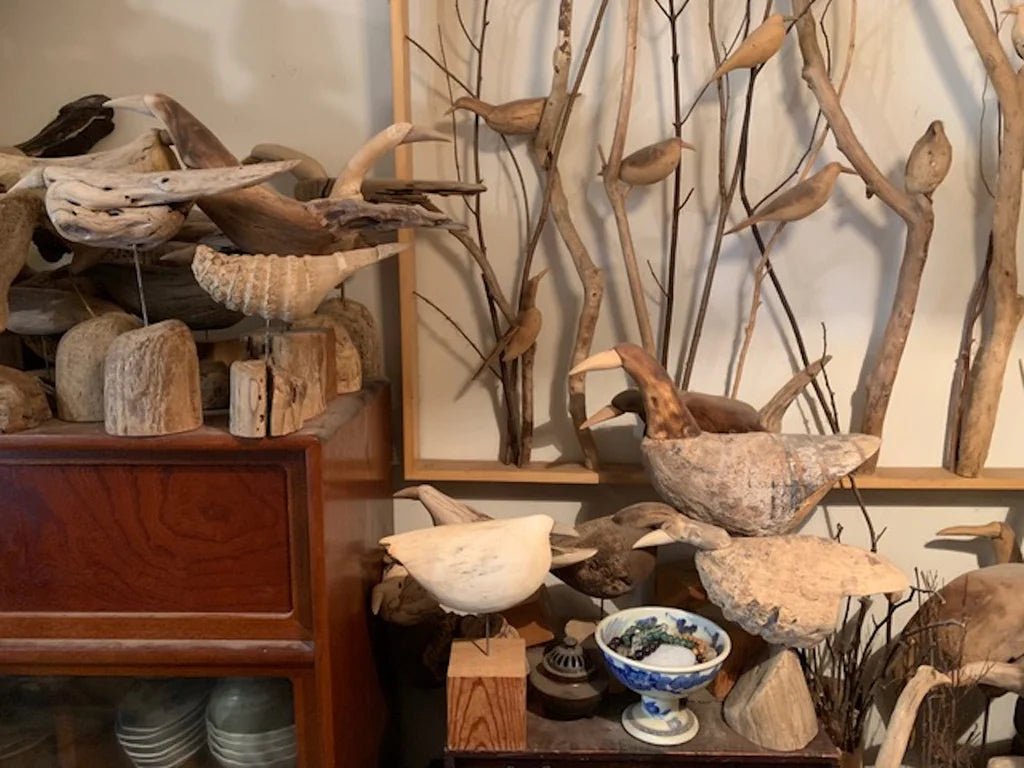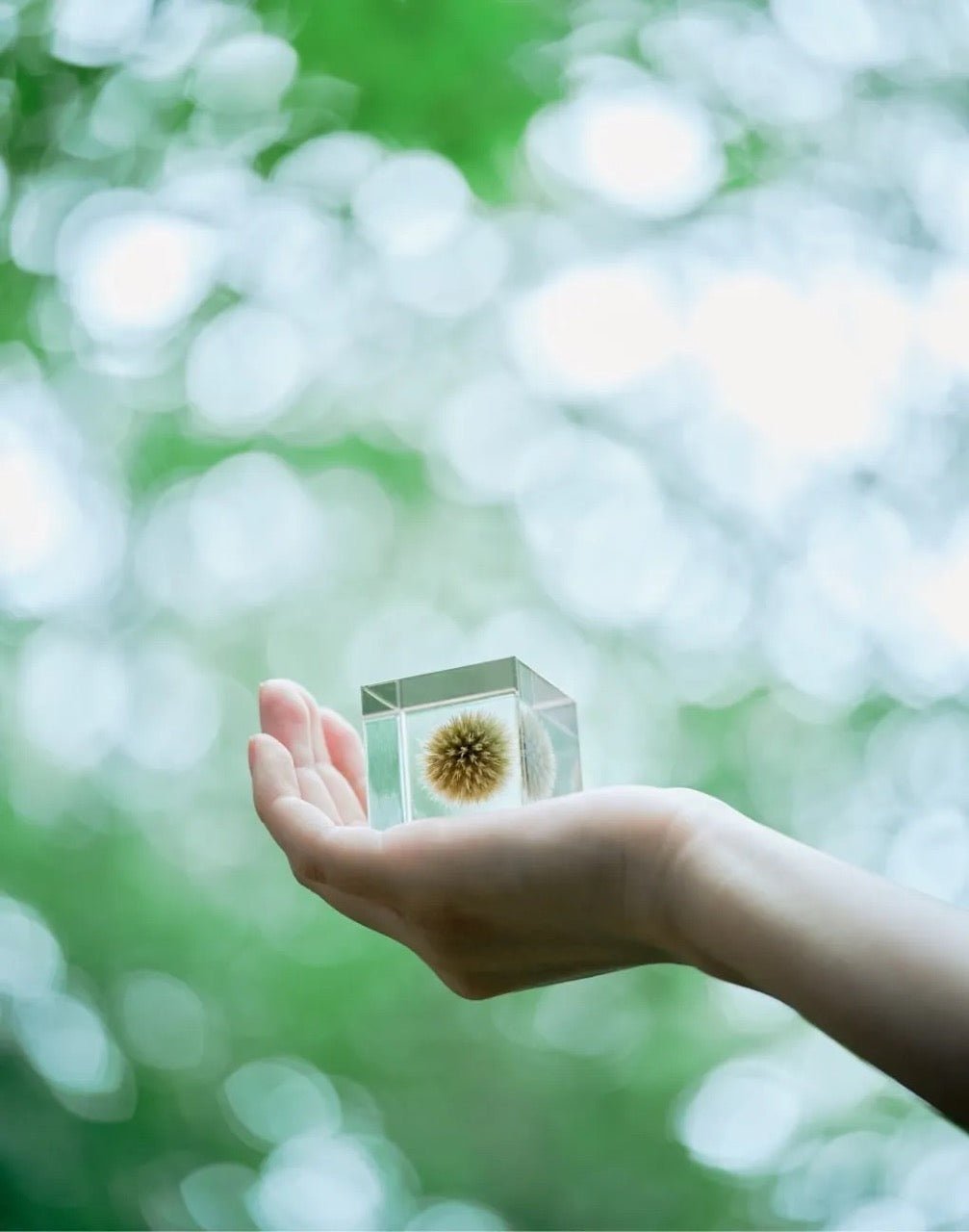E: What made you start making driftwood birds?
O: It started 40 years ago during the dead of winter; I found a piece of driftwood on a beach in Hayama. The beautiful streamline form created by nature, the burnt grain of the wood that looked like feathers, and the texture and color from the tree were all fascinating. Since then, I've searched for driftwood every weekend. On one of those days of searching, I found a piece of driftwood that looked like a bird and attached a beak to it. This transformed the driftwood into a perfect bird. After this I was captivated by driftwood birds and started collecting for the sole purpose of making them. What I find interesting and fun is turning these abandoned pieces of driftwood into a wonderful bird with a renewed purpose. Driftwood is infused with an overwhelming power and sense of nature that can't be artificially created, and their attraction is that no two pieces have the same shape. I'm still addicted to the original bird that was born out of driftwood, and I haven't tired of it for 40 years.
I suppose the driftwood I find also become birds because I grew up with birds in downtown Tokyo. My father had a hobby since I was a child of keeping and collecting chicken, java sparrows, and budgerigars as pets. This might have had an effect on me.
E: Tell us the process of making one of your birds. When you're searching for driftwood, what are you looking for?
O: Searching for driftwood usually goes from autumn to spring. Strong winds in spring, typhoons in autumn, and winter without people are ideal for finding driftwood. I'll walk for half a day looking for driftwood and it's never guaranteed I'll find any good pieces of driftwood when I go out. It's all a chance encounter. Birds are born by accident. But I search for driftwood that looks like a beak and parts of driftwood that can likely become the bird's body. Sometimes I'll collect driftwood simply because it has an interesting shape, and then after a few years, if you look at it again, you can often find it will make an interesting bird.
There are multiple processes to making a bird. You can pick the wood first, and make the bird based on that shape, or sometimes you select the wood to match the bird you want to make. Sometimes I'll have a client who orders a specific looking bird. When this happens, I search for the piece of driftwood that suits their request; the method of making the driftwood that fits the image of the bird you want to make. Basically, I make birds that bring out the individual characteristics of each piece of unique driftwood. This is my way. Be careful with driftwood and protect its originality. Everything is a gift of chance - a happy accident.
E: How has your life changed due to the coronavirus? Has it been easier or harder to be creative during this time?
O: During this time of the coronavirus, I've had more time to make my work, and I'm grateful for this. I've been having a good time focusing on work. My cats are spending time with me, next to me as I work, without disturbing me. I'm glad to spend my time at home and not somewhere more crowded or congested.
E: Because of our current health crisis, many people have sought relief and peace by being in nature. How do you think this relates to your work? What are you trying to express through making driftwood birds?
O: Everything has changed from this experience with the coronavirus. Our way of working, of having fun, the fundamental way we live have all been subject to change in a historical way. Many of us are working remotely, and adjusting to a new normal. We can't go to to the beach, we can't go to the mountains, everything is a little more stressful. The other day, a store owner who sells my birds in Tokyo told me one of his customers felt healed by looking at my birds and took one home. I was thrilled to hear that. I think people can associate my driftwood birds with oceans and rivers. This may be especially useful at a time like this. It's been almost 40 years since I started making driftwood birds, and I can confidently say that driftwood birds bring me peace of mind and healing because they're very lovable. I'm proud I've given citizenship to driftwood as a material in the sense that I've reimagined them as new beings. Currently, in Japan, the number of creators using driftwood as a material has increased, and I'm happy about this too. It would be nice if we could all pay more attention to the natural materials we can find in our lives.
E: What are you looking forward to the most when things return to normal?
O: I'd like to go to Hawaii. I've visited every year to see friends, but it's hard right now because we can't travel.
Thank you Osamu-san for this amazing insight into your creative work and for taking the time to answer all of our questions so thoughtfully. We hope you'll be able to see your friends in Hawaii soon, and that you continue to stay safe in Tokyo.
To read the original Japanese version of this interview, click here. And to purchase some of Osamu's beautiful Driftwood Bird sculptures, find them on our online store. To see Osamu's works in person, be sure to book an in-store appointment to come and see us.








